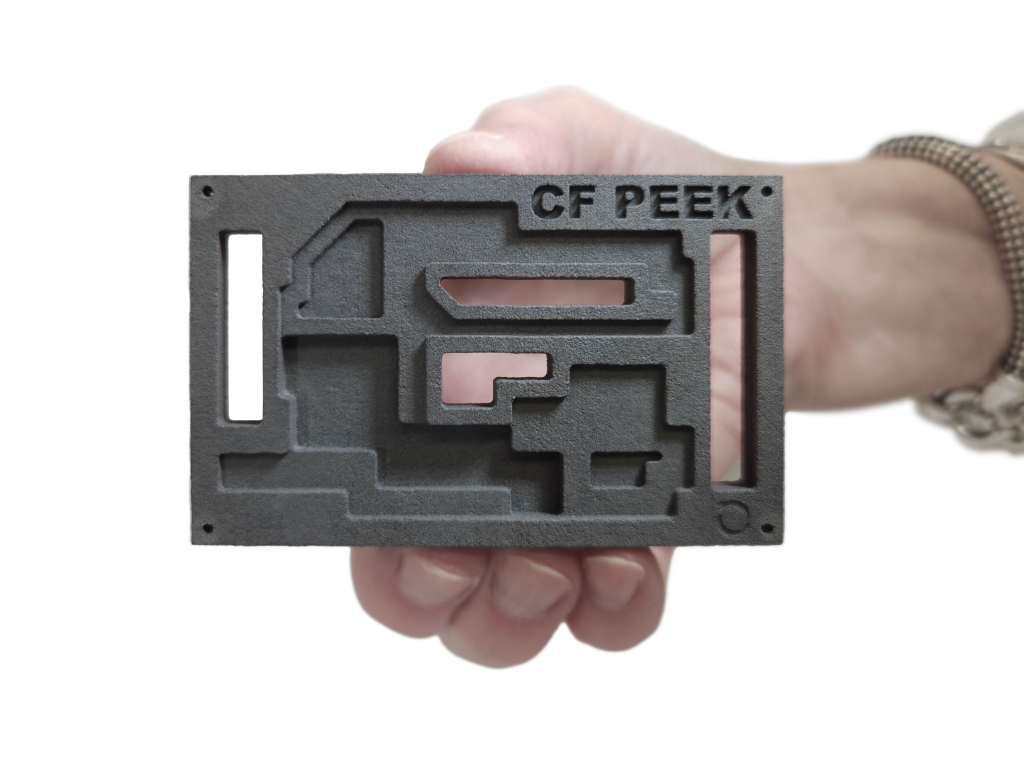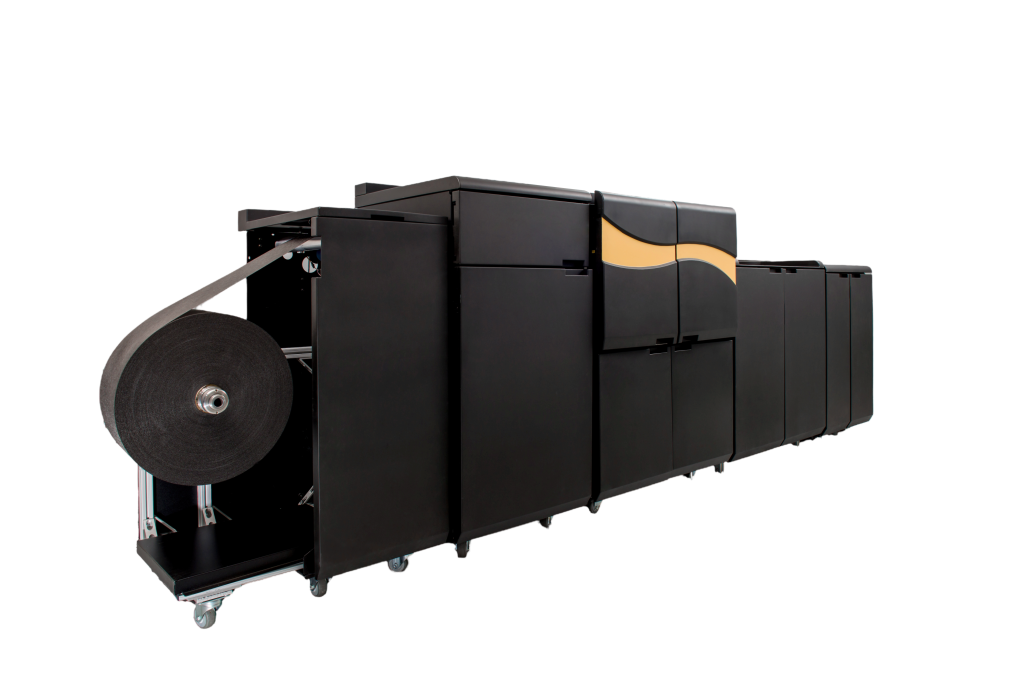Impossible Objects has unveiled a new 3D printing system that is 15 times faster than its competitors. The CBAM 25 printer, which is capable of operating at 25 feet per minute, has the potential to revolutionize the industry with its increased speed and efficiency.
3D Printing Industry spoke to Impossible Objects founder, Bob Swartz and company CEO Steve Hoover to learn more about Composite Based Additive Manufacturing, CBAM, and how Impossible Objects is targeting CNC machining with speed and precision, and how 15x is only the beginning.

How does CBAM additive manufacturing work?
Impossible Objects founder, Bob Swartz, explains that, like other 3D printing processes, they start with a CAD model, and slice it into layers. CBAM then prints the layers onto a carbon fiber sheet using an inkjet head and an aqueous fluid. They then flood the sheet with a polymer powder, which sticks to the fluid, and vacuum off the excess powder. The sheets are stacked, heated, and compressed to fuse together, then the unfused carbon fiber is removed, leaving a 3D object. The advantages of CBAM technology include stronger materials, faster production, compatibility with various thermoplastic powders, better dimensional accuracy, no warpage or shrinkage, and lower costs, according to the company.
Hoover explained that the CBAM 25’s speed advantage is due to several factors, including the printing process being carried out at room temperature. “We don’t have the FDM or SLS process where you melt and cool and melt and cool. That is what makes a lot of these processes very slow. There’s a thermal time constraint or curing process with UV,” he said.
Swartz added that the company’s 3D printers also have a higher packing density than their competitors, which increases productivity. “The packing density is critical because they can only get, you know, six or seven percent packing densities of their parts, whereas we can get much higher packing densities because the problems with the heating between parts are not an issue in our process,” Swartz said.
To summarise, the 15 times speed increase is based on three factors: the speed of creating each layer, the thickness of the layers, and the packing density of the parts within the build block.
Among the new applications for the CBAM 25 is a pocket version of a wave solder palette, a type of fixture used in soldering circuit boards. Wave soldering is an industrial, high-volume soldering process that rapidly produces circuit boards. In the process, the circuit boards are placed onto a raft or palette and pass over a vat of molten solder. During our call, Hoover demonstrated a 3D printed pocket palette, stating, “This is a part we can print every 15 seconds.” The palette illustrates a core value proposition, bringing the 3D printing element of a workflow up to the speed of other industrial systems in a process chain.

Speeding Up 3D Printing: A Moore’s Law Moment?
The company’s founder, Bob Swartz, refers to their technology as a “Moore’s Law moment for 3D printing.” This is only the first step, as the technology they are applying has the potential for significant improvements. The current machine is designed to run at 25 feet per minute, and Swartz sees the possibility of machines running at 100 feet per minute or faster in the future. This continued innovation could lead to even greater growth in the 3D printing market, expanding its reach into new industries and applications.
The 3D printing market, valued at $24 billion today, is projected to grow to $50 billion by the end of the decade. This growth is expected to come from higher volume manufacturing applications. New technologies, like those developed by Impossible Objects, aim to take a substantial share of this growth by focusing on speed and materials. “I’d be happy if we grabbed 10% of that 50 billion market a year; that’d be pretty good,” says Hoover.
Hoover explains that they are not trying to be cheaper than other high-end 3D printers but faster. Their process is inherently composite, and they are currently working with materials such as fiberglass, nylon, PEEK, and carbon fiber. The company aims to target high-performance polymers and metal replacements, as their technology has the strength-to-weight ratio of aluminum.
Hoover joined Impossible Objects in 2022, having spent over a decade with Xerox, including time as CEO of the company’s Palo Alto Research Center, aka PARC, and later as CTO of Xerox. Bringing the experience to Impossible Objects bodes well for their impressive vision. Hoover describes this as “know-how from high-speed digital printing.” He explains the Xerox digital printers printed at 300 pages a minute, “You know, 300 layers a minute, if you will, right?”
Limitations and Opportunities
Despite the impressive speed and material capabilities of this new 3D printer, there are limitations to its technology. Currently, the printer can only print objects up to five inches in height, and there are restrictions when it comes to printing enclosed volumes and long channels. However, the company can produce complicated support structures and is working on eliminating the height restrictions.
The company has already received interest from several industries, including aerospace, where lightweighting for drones is a key focus. Additionally, the company sees potential in end effectors for robotics, thermoforming molds, and other niche applications where stiffness and heat resistance are important.
Impossible Objects applications and future plans
End-use applications are critical to the adoption of additive manufacturing. So, where in the market is Impossible Objects setting its sights? “The electronics tooling market is somewhere between one and a half or two billion dollars globally. We believe we have a significant advantage in time and costs,” says Hoover. He estimates that Impossible Objects could capture “10 to 30% of that by dollar volume.”
Swartz highlights that their technology is competing with both additive manufacturing and traditional manufacturing methods like CNC machining. He explains, “We’re seeing this in the electronics business, substantial ability to compete with CNC machining, we can hold 100-micron tolerances.” This allows Impossible Objects to compete in various markets with lower volume demands.
Hoover mentions another promising area of applications for Impossible Objects, pointing towards $7 million in R&D grants the company has received from the US Air Force. The application is the lightweighting of drones. He points to a picture on the office wall of a high-blade count drone propeller. “Our carbon fiber PEEK can handle the rotational stresses associated with drone bodies with the strength to weight of aluminum,” he says, “There’s a lot of interest in the drone space.”
Regarding Impossible Objects’ plans to increase the speed of their technology, Hoover says, “We’re making the key technology selections and the basic architecture of the machine and designing that modularly in a way that we believe enables us to make those speed upgrades without fundamentally starting from scratch and redesigning the whole machine.” While their goal is to achieve a 4x speed increase, moving from 25 ft/min to 100 ft/min, Hoover also mentions that their customers’ needs will determine part of their focus, whether it be “speed, materials, or tolerances.”
At the upcoming RAPID & TCT event in Chicago, Hoover encourages attendees to visit Impossible Objects’ booth, stating, “We have the proof we believe to back this up. We’re going to show you real parts.” They are looking for early adopter customers and plan to install “six to eight machines next year.”
The Industrialization of Additive Manufacturing
The industrialization of additive manufacturing will likely be a much-discussed topic in Chicago next week. Swartz says, “The challenges for additive are materials and speed.” He emphasizes the importance of “lowering costs and increasing speed” while “increasing the properties of what you’re building.” Swartz believes that Impossible Objects’ technology can do all three and is already doing them today.
Hoover gave his thoughts on the industrialization of additive manufacturing, stating, “The customer side wants it; they understand now the theoretical benefits of 3D.” He points out that customers recognize the value of generative AI designs for lightweighting and the quick turnaround times offered by 3D printing. Hoover believes that the market’s demand for these capabilities is creating a perfect opportunity for Impossible Objects to be a key player in the next stage of industrialization.
To stay up to date with the latest 3D printing news, don’t forget to subscribe to the 3D Printing Industry newsletter or follow us on Twitter or liking our page on Facebook.
While you’re here, why not subscribe to our Youtube channel? featuring discussion, debriefs, video shorts, and webinar replays. Are you looking for a job in the additive manufacturing industry? Visit 3D Printing Jobs for a selection of roles in the industry.
Featured image shows CBAM 3D printing in Carbon Fiber PEEK. Photo via Impossible Objects.



